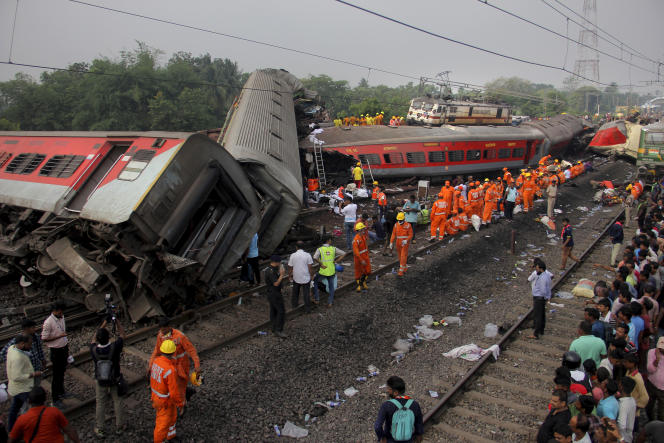India, a land of bustling railways that connect millions of lives, has long been plagued by train accidents that shatter dreams and leave behind trails of devastation. These incidents have not only claimed countless lives but have also raised serious concerns about the safety and infrastructure of the Indian rail network. As we delve into the depths of this tragic tale, it is essential to understand the causes, consequences, and the efforts being made to prevent future train accidents in India.
A Bleak History:
Indian train accidents have left an indelible mark on the nation’s psyche. Over the years, the country has witnessed numerous tragedies, including derailments, collisions, and bridge collapses, resulting in tragic loss of lives and injuries. Factors contributing to these accidents are multifaceted, ranging from poor maintenance, outdated infrastructure, overcrowding, human error, and sometimes even sabotage.
Causes and Consequences:
- Poor Infrastructure and Maintenance: The Indian railway network, one of the largest in the world, suffers from outdated infrastructure and inadequate maintenance. Aging tracks, faulty signaling systems, and poor inspection mechanisms have contributed to accidents, as they fail to detect and rectify potential hazards in a timely manner.
- Overcrowding: India’s vast population, coupled with limited transportation options, often leads to overcrowded trains. Passengers travel on footboards, rooftops, and even cling to the sides of trains, endangering their lives and increasing the chances of accidents.
- Human Error: The human factor cannot be overlooked when examining train accidents. Instances of negligence, including signal jumping, speeding, and improper communication, have led to catastrophic outcomes. Addressing human error through improved training, stringent protocols, and enhanced monitoring systems is crucial to reducing accidents.
- Sabotage: Regrettably, train accidents in India have also been the result of malicious acts of sabotage. These incidents, perpetrated by individuals or groups with malicious intent, further compound the challenge of ensuring rail safety.
The Road to Safety:
In response to the alarming number of train accidents, the Indian Railways has undertaken various initiatives to enhance safety measures:
- Modernization and Upgradation: The Indian government has allocated significant funds for the modernization and upgradation of railway infrastructure. This includes the adoption of advanced signaling systems, track renewal programs, and the introduction of technology-driven solutions for better maintenance and safety.
- Awareness and Education: Promoting safety awareness among railway staff, passengers, and communities living near railway tracks is crucial. The Indian Railways has been conducting campaigns and awareness programs to educate people about the hazards of trespassing, overcrowding, and other risky behaviors.
- Enhanced Monitoring Systems: The introduction of advanced technology, such as the implementation of automatic train protection systems, has shown promise in preventing accidents caused by human error. These systems can monitor train speed, maintain safe distances between trains, and provide real-time alerts to prevent collisions.
- Collaboration with International Experts: Indian Railways has sought collaborations with international experts and organizations to learn from global best practices and implement them in the Indian context. This exchange of knowledge and expertise can significantly contribute to improving safety standards.
The story of Indian train accidents is a tragic one that needs urgent attention and action. While progress has been made, challenges remain. The Indian Railways, along with the government and stakeholders, must continue their concerted efforts to enhance infrastructure, invest in modernization, and prioritize safety measures. By addressing the root causes, raising awareness, and leveraging advanced technologies, India can strive towards a future where train travel is safe, reliable, and a source of pride for the nation. It is imperative that every life lost in these accidents serves as a reminder of the work that still needs to be done to ensure a safer railway system for all.
Improved Emergency Response: In the wake of train accidents, a prompt and efficient emergency response is crucial. Indian Railways has been working on strengthening its emergency response capabilities by establishing dedicated rescue teams, equipping them with modern equipment, and conducting regular drills to ensure swift action in case of accidents.
Focus on Maintenance and Inspection: Regular maintenance and inspection of tracks, bridges, and rolling stock are essential to prevent accidents. Indian Railways has been investing in modern inspection technologies, such as ultrasonic flaw detection systems and track geometry cars, to identify potential defects and take proactive measures.
Upgrading Rolling Stock: Alongside infrastructure development, the modernization of rolling stock is essential. The introduction of safer and technologically advanced locomotives, coaches, and wagons can contribute to accident prevention. Indian Railways has been in the process of upgrading its fleet with features like anti-collision devices, improved braking systems, and crash-worthy designs.
Enhancing Driver Training: The training of locomotive drivers is of paramount importance in ensuring safe train operations. Indian Railways has been focusing on enhancing driver training programs, including simulator-based training, to improve their skills, awareness, and adherence to safety protocols.
Public-Private Partnerships: To accelerate the pace of infrastructure development and improve safety standards, Indian Railways has been exploring public-private partnerships (PPPs). This approach allows for leveraging private sector expertise, investment, and innovation in upgrading railway infrastructure and implementing advanced safety measures.
Safety Audits and Investigations: Conducting regular safety audits and thorough investigations following accidents is crucial to identify lapses, determine accountability, and implement corrective measures. Indian Railways has been strengthening its safety auditing process and establishing dedicated accident investigation teams to ensure lessons are learned and corrective actions are taken.
Strengthening Legal Framework: A robust legal framework is necessary to enforce safety standards, hold accountable those responsible for negligence or sabotage, and ensure that proper compensation is provided to victims and their families. The Indian government has been working on strengthening the legal framework related to rail safety and accident investigations.
Community Engagement: Engaging with local communities and stakeholders is vital for promoting safety awareness and fostering a culture of responsible rail usage. Indian Railways has been actively involving communities living near railway tracks in safety campaigns, sensitizing them to the risks associated with trespassing, and encouraging their active participation in ensuring safer railway operations.
In conclusion, Indian train accidents demand a comprehensive and multi-faceted approach to tackle the underlying causes and improve safety standards. With a focus on infrastructure development, technology adoption, training, and community involvement, India can strive towards a future where train accidents become a thing of the past, ensuring safer and more reliable rail travel for all.



No Comments
Leave Comment